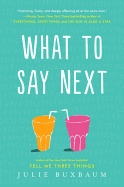What to Say Next is abo ut two teens in high school finding their way to truth. The novel features dual narration from the two main characters Kit Lowell and David Drucker. Kit, a usually outgoing girl, is struggling to make sense of her world with her father’s recent death. She befriends David, a frank and relatively lonely person. David lacks in social skills as a result of his autism, but is eager to have a friend. They bond quickly, becoming closer friends and finding comfort in each other’s company. Kit asks David to help her uncover the mystery of her dad’s car accident, but their friendship is put to the test when they reach the truth.
ut two teens in high school finding their way to truth. The novel features dual narration from the two main characters Kit Lowell and David Drucker. Kit, a usually outgoing girl, is struggling to make sense of her world with her father’s recent death. She befriends David, a frank and relatively lonely person. David lacks in social skills as a result of his autism, but is eager to have a friend. They bond quickly, becoming closer friends and finding comfort in each other’s company. Kit asks David to help her uncover the mystery of her dad’s car accident, but their friendship is put to the test when they reach the truth.
Throughout the novel, the characterization is well developed and strengthens the writing. David starts off as an intelligent and analytical character, and is hard to relate to because of his unique perspective on the world. He does not have many social skills, and is further separated from his peers due to his label as a “retard”. The tone and diction of his chapters illustrate his rational mind, and it’s clear that he needs certainty. Later, he becomes more relatable and is not defined by labels. He is truly seen as a person instead of a stereotypical misunderstood teen.
Additionally, the hierarchy of typical high schools is pointed out to be unfair and biased. When David defends himself from the foot, the principal suggests moving him to another school. Instead of removing the bullies from the situation, the victim is targeted and told to start over at another school. Principal Hoch is valuing the football stars, and trying to protect them rather than David. She is unjustly perpetuating the high school hierarchy and labeling people. She even refuses to hear David’s side of the story, and does not care about his several death threats. This focuses on the harmful effects of valuing certain individuals over others, and using damaging labels without seeing beyond them. It leads to the people on top becoming complacent, and the people at the bottom being confined to their labels and unable to safely be themselves.
Ultimately, What to Say Next explores important themes of identity and friendship. I would rate it a ⅘ stars, and would recommend it to anyone interested. Thank you so much to Bookshop SC for providing me with the opportunity to read and review this ARC, and I can’t wait to read the final published copy in July.-Genevieve B
